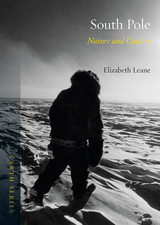2 books about Leane, Elizabeth

Cinematic Canines
Dogs and Their Work in the Fiction Film
McLean, Adrienne L
Rutgers University Press, 2014
Dogs have been part of motion pictures since the movies began. They have been featured onscreen in various capacities, from any number of “man’s best friends” (Rin Tin Tin, Asta, Toto, Lassie, Benji, Uggie, and many, many more) to the psychotic Cujo. The contributors to Cinematic Canines take a close look at Hollywood films and beyond in order to show that the popularity of dogs on the screen cannot be separated from their increasing presence in our lives over the past century.
The representation and visualization of dogs in cinema, as of other animals, has influenced our understanding of what dogs “should” do and be, for us and with us. Adrienne L. McLean expertly shepherds these original essays into a coherent look at “real” dogs in live-action narrative films, from the stars and featured players to the character and supporting actors to those pooches that assumed bit parts or performed as extras. Who were those dogs, how were they trained, what were they made to do, how did they participate as characters in a fictional universe? These are a just a few of the many questions that she and the outstanding group of scholars in this book have addressed.
Often dogs are anthropomorphized in movies in ways that enable them to reason, sympathize, understand and even talk; and our shaping of dogs into furry humans has had profound effects on the lives of dogs off the screen. Certain breeds of dog have risen in popularity following their appearance in commercial film, often to the detriment of the dogs themselves, who rarely correspond to their idealized screen versions. In essence, the contributors in Cinematic Canines help us think about and understand the meanings of the many canines that appear in the movies and, in turn, we want to know more about those dogs due in no small part to the power of the movies themselves.
The representation and visualization of dogs in cinema, as of other animals, has influenced our understanding of what dogs “should” do and be, for us and with us. Adrienne L. McLean expertly shepherds these original essays into a coherent look at “real” dogs in live-action narrative films, from the stars and featured players to the character and supporting actors to those pooches that assumed bit parts or performed as extras. Who were those dogs, how were they trained, what were they made to do, how did they participate as characters in a fictional universe? These are a just a few of the many questions that she and the outstanding group of scholars in this book have addressed.
Often dogs are anthropomorphized in movies in ways that enable them to reason, sympathize, understand and even talk; and our shaping of dogs into furry humans has had profound effects on the lives of dogs off the screen. Certain breeds of dog have risen in popularity following their appearance in commercial film, often to the detriment of the dogs themselves, who rarely correspond to their idealized screen versions. In essence, the contributors in Cinematic Canines help us think about and understand the meanings of the many canines that appear in the movies and, in turn, we want to know more about those dogs due in no small part to the power of the movies themselves.
[more]

South Pole
Nature and Culture
Elizabeth Leane
Reaktion Books, 2016
As one of two points where the Earth’s axis meets its surface, the South Pole should be a precisely defined place. But as Elizabeth Leane shows in this book, conceptually it is a place of paradoxes. An invisible spot on a high, featureless ice plateau, the Pole has no obvious material value, yet it is a highly sought-after location, and reaching it on foot is one of the most extreme adventures an explorer can undertake. The Pole is, as Leane shows, a deeply imagined place, and a place of politics, where a series of national claims converge.
Leane details the important challenges that the South Pole poses to humanity, asking what it can teach us about ourselves and our relationship with our planet. She examines its allure for explorers such as Robert F. Scott and Roald Amundsen, not to mention the myriad writers and artists who have attempted to capture its strange, inhospitable blankness. She considers the Pole’s advantages for climatologists and other scientists as well as the absurdities and banalities of human interaction with this place. Ranging from the present all the way back to the ancient Greeks, she offers a fascinating—and lavishly illustrated—story about one of the strangest and most important places on Earth.
Leane details the important challenges that the South Pole poses to humanity, asking what it can teach us about ourselves and our relationship with our planet. She examines its allure for explorers such as Robert F. Scott and Roald Amundsen, not to mention the myriad writers and artists who have attempted to capture its strange, inhospitable blankness. She considers the Pole’s advantages for climatologists and other scientists as well as the absurdities and banalities of human interaction with this place. Ranging from the present all the way back to the ancient Greeks, she offers a fascinating—and lavishly illustrated—story about one of the strangest and most important places on Earth.
[more]
READERS
Browse our collection.
PUBLISHERS
See BiblioVault's publisher services.
STUDENT SERVICES
Files for college accessibility offices.
UChicago Accessibility Resources
home | accessibility | search | about | contact us
BiblioVault ® 2001 - 2024
The University of Chicago Press









